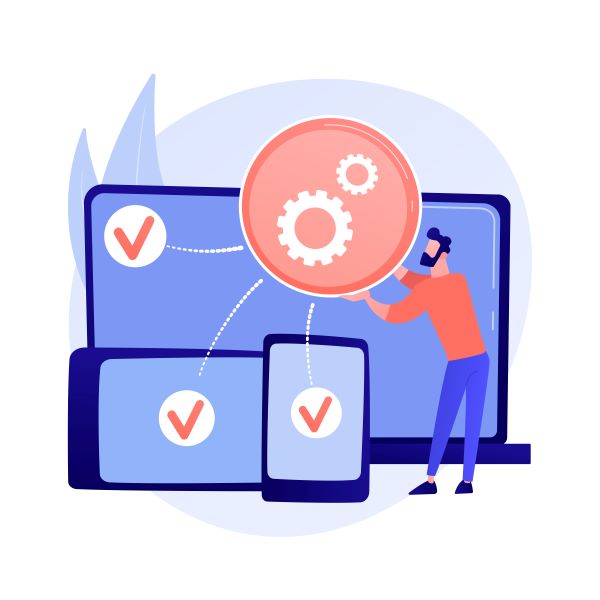Regular vulnerability scans help organizations identify security weaknesses before they are exploited, prioritize efforts, and maintain a strong security posture. Key features to look for in scanning tools include continuous scanning, agentless approach, risk-based prioritization, cross-cloud/technology support, scanning before deployment, comprehensive workload coverage, data visualization, and integration capabilities.
Here are the top 10 app vulnerability scanning tools for 2024:
- Veracode - Integrates with CI/CD pipelines, supports multiple languages, offers SAST, DAST, IAST, and SCA scanning.
- Appknox - Focuses on mobile app security, integrates with CI/CD, supports hybrid/native apps, offers static/dynamic/API testing.
- OpenVAS - Open-source, offers unauthenticated/authenticated testing, supports various protocols, customizable.
- Nmap - Network scanning tool with Nmap Scripting Engine (NSE) for vulnerability detection, real-time monitoring.
- Tenable.io Nessus - Configuration auditing, vulnerability analysis, sensitive data discovery, real-time monitoring.
- Qualys Vulnerability Management Scanner - Scans IT/OT/IoT devices, web apps, risk ratings based on multiple factors.
- Rapid7 InsightVM - Intuitive UI, scalable, integrates with patch management systems.
- Invicti - Integrates with CI/CD, verifies vulnerabilities, user-friendly interface.
- Acunetix - Integrates with CI/CD, vulnerability verification, compliance reporting, automated scanning.
- HCL AppScan - Integrates with CI/CD, multi-analysis, large-scale dynamic testing, customizable policies.
Integrating scanning tools into the development process enables early vulnerability detection, risk reduction, compliance, and increased efficiency.
Related video from YouTube
Quick Comparison
ToolContinuous ScanningAgentlessRisk PrioritizationCross-Cloud/Tech SupportPre-Deployment ScanningWorkload CoverageData VisualizationIntegrationVeracode✓✓✓✓✓✓✓✓Appknox✓✓✓✓✓✓✓✓OpenVAS✓✓✓✓✓✓✓✓Nmap✓✓✓✓✓✓✓✓Tenable.io Nessus✓✓✓✓✓✓✓✓Qualys✓✓✓✓✓✓✓✓Rapid7 InsightVM✓✓✓✓✓✓✓✓Invicti✓✓✓✓✓✓✓✓Acunetix✓✓✓✓✓✓✓✓HCL AppScan✓✓✓✓✓✓✓✓
What is App Security Scanning?
App security scanning is a process that identifies and detects vulnerabilities in web applications to prevent potential security breaches. It simulates real-world attacks to identify weaknesses in an application's security posture.
How App Security Scanning Works
App security scanning tools test web applications while they are running, identifying vulnerabilities that cannot be detected through static analysis. These tools simulate attacks, such as:
- Cross-site scripting (XSS)
- SQL injection
- Buffer overflows
Benefits of App Security Scanning
The benefits of app security scanning include:
BenefitDescriptionImproved SecurityIdentify and mitigate vulnerabilities before they are exploitedComplianceMeet compliance audit requirementsTransaction SecurityImprove transaction securityStrong Security PostureMaintain a strong security posture
By performing regular vulnerability scans, organizations can stay ahead of potential threats, protect their business assets, and maintain a vigilant approach to security.
Key Features to Look For
When evaluating app vulnerability scanning tools, there are several key features to look for to ensure you're getting the best solution for your organization. Here are some essential criteria to consider:
Continuous Scanning Capability
Choose a tool that can continuously scan and detect vulnerabilities as they emerge, ensuring your organization is consistently vulnerability-free.
Agentless Approach
Opt for a tool that utilizes an agentless approach, eliminating the need to install and manage scanning agents on target systems.
Risk-Based Prioritization
Select a tool that provides risk-based prioritization of vulnerabilities, considering factors such as severity, exploitability, and asset criticality.
Cross-Cloud/Cross-Technology Support
Ensure the tool can scan different storage environments and cloud providers, including AWS, GCP, Azure, OCI, and Alibaba Cloud, regardless of the underlying OS or programming language.
Scanning Before Deployment
Look for a tool that can scan virtual machines (VMs) and containers and detect potential vulnerabilities in them before their deployment.
Comprehensive Workload Coverage
Choose a tool that can simultaneously scan various systems and workloads, including servers, endpoints, databases, and web applications.
Data-Based Visualization Reports
Opt for a tool that provides visual representation of vulnerability data in various formats, such as tables, graphs, and charts.
Integration
Ensure the tool seamlessly integrates with other security solutions, including SIEM, log management, and SCM tools.
Here is a summary of the key features to look for in an app vulnerability scanning tool:
FeatureDescriptionContinuous ScanningContinuously scan and detect vulnerabilitiesAgentless ApproachEliminate the need for scanning agents on target systemsRisk-Based PrioritizationPrioritize vulnerabilities based on severity, exploitability, and asset criticalityCross-Cloud/Cross-Technology SupportScan different storage environments and cloud providersScanning Before DeploymentDetect vulnerabilities in VMs and containers before deploymentComprehensive Workload CoverageScan various systems and workloads simultaneouslyData-Based Visualization ReportsVisual representation of vulnerability dataIntegrationSeamless integration with other security solutions
By considering these key features, you can ensure that your organization is well-equipped to detect and mitigate vulnerabilities in your applications.
1. Veracode

Veracode is a comprehensive app vulnerability scanning tool that helps companies detect and mitigate security threats. It offers on-demand expertise, various pricing options, including a free trial and a free/freemium version.
Integration with CI/CD Pipelines
Veracode integrates seamlessly with CI/CD pipelines, allowing developers to identify and fix security vulnerabilities early in the development cycle. This integration automates security testing, reduces risk, and improves overall application security.
Support for Multiple Programming Languages and Frameworks
Veracode supports a wide range of programming languages and frameworks, including:
Language/FrameworkSupportedJavaC#.NETASP.NETC++JavaScriptScala
Advanced Scanning Technologies
Veracode offers advanced scanning technologies, including:
TechnologyDescriptionSAST (Static Application Security Testing)Analyzes code at the binary level, identifying security flaws and providing detailed remediation guidance.DAST (Dynamic Application Security Testing)Simulates real-world attacks to identify vulnerabilities in running applications.IAST (Interactive Application Security Testing)Provides real-time security testing and feedback during development.SCA (Software Composition Analysis)Helps manage open-source component risks.
With its robust features and advanced scanning technologies, Veracode is an excellent choice for organizations seeking to improve their application security posture.
2. Appknox

Appknox is a comprehensive mobile application security platform that helps developers, security researchers, and enterprises build a safe and secure mobile ecosystem. It offers a system plus human approach to outsmart hackers and provides a range of features to ensure mobile app security.
Integration with CI/CD Pipelines
Appknox integrates seamlessly with CI/CD pipelines, allowing developers to identify and fix security vulnerabilities early in the development cycle. This integration automates security testing, reduces risk, and improves overall application security.
Supported Programming Languages and Frameworks
Appknox supports a wide range of programming languages and frameworks, including:
Language/FrameworkSupportedHybrid applicationsNative applications
Advanced Scanning Technologies
Appknox offers advanced scanning technologies, including:
TechnologyDescriptionStatic code analysisAnalyzes code to identify security flawsDynamic analysisSimulates real-world attacks to identify vulnerabilitiesAPI testingTests APIs to identify potential security risks
With its robust features and advanced scanning technologies, Appknox is an excellent choice for organizations seeking to improve their mobile application security posture.
3. OpenVAS

OpenVAS is an open-source vulnerability scanner that helps identify and mitigate security vulnerabilities in applications. Developed and maintained by Greenbone Networks, OpenVAS is a popular choice among security professionals and organizations.
Advanced Scanning Technologies
OpenVAS offers advanced scanning technologies, including:
TechnologyDescriptionUnauthenticated and authenticated testingTests applications with and without authenticationHigh-level and low-level internet and industrial protocolsSupports various protocols for comprehensive scanningPerformance tuning for large-scale scansOptimizes scanning for large-scale environmentsScripting engineAllows customization and extension of functionalities
Support for a Wide Range of Systems and Applications
OpenVAS supports a wide range of systems and applications, making it a versatile tool for vulnerability scanning. Its vast collection of plugins enables comprehensive vulnerability scanning across various systems and applications.
Community Contributions and Scalability
OpenVAS benefits from a vibrant community of users who actively contribute to its development, providing regular updates and improvements. Its scalability makes it suitable for organizations with complex infrastructures, allowing it to handle large-scale network environments.
With its advanced scanning technologies, wide range of plugins, and scalability, OpenVAS is an excellent choice for organizations seeking to improve their application security posture.
4. Nmap

Nmap is an open-source network scanning tool that can be used for vulnerability scanning. It is known for its flexibility, power, and ease of use. Nmap uses raw IP packets to determine what hosts are available on the network, what services they are offering, and what operating systems they are running.
Advanced Scanning Technologies
Nmap comes with the Nmap Scripting Engine (NSE) that helps detect misconfiguration issues and security vulnerabilities. The NSE scripts are categorized into various groups, including:
Script CategoryDescriptionauthAuthentication-related scriptsbroadcastScripts that discover hosts and servicesbruteScripts that perform brute-force attacksdefaultScripts that are run by defaultdiscoveryScripts that discover hosts and servicesdosScripts that perform denial-of-service attacksexploitScripts that exploit vulnerabilitiesexternalScripts that interact with external servicesfuzzerScripts that perform fuzz testingintrusiveScripts that perform intrusive testingmalwareScripts that detect malwaresafeScripts that are safe to runversionScripts that detect version informationvulnScripts that detect vulnerabilities
Support for a Wide Range of Systems and Applications
Nmap supports a wide range of systems and applications, making it a versatile tool for vulnerability scanning. It can be used to scan for vulnerabilities in web applications, networks, and operating systems.
Real-time Monitoring and Alerting Capabilities
Nmap can be used to monitor networks and systems in real-time, allowing for quick detection of vulnerabilities and potential security threats. Its alerting capabilities enable security professionals to respond quickly to potential security threats, reducing the risk of security breaches.
With its advanced scanning technologies, support for a wide range of systems and applications, and real-time monitoring and alerting capabilities, Nmap is an excellent choice for organizations seeking to improve their application security posture.
5. Tenable.io Nessus

Tenable.io Nessus is a comprehensive vulnerability scanning tool that helps organizations identify and remediate vulnerabilities. With its advanced scanning technologies, Nessus provides detailed reports on vulnerabilities, misconfigurations, and weak passwords.
Advanced Scanning Technologies
Nessus offers various plugins to scan for different types of vulnerabilities, including network, web, and cloud-based vulnerabilities. Its advanced scanning technologies include:
TechnologyDescriptionConfiguration AuditingChecks system configurations against best practices and identifies misconfigurations that can lead to security vulnerabilities.Vulnerability AnalysisIdentifies security vulnerabilities in networks, systems, and applications, providing detailed reports on the severity and impact of each vulnerability.Sensitive Data DiscoveryDetects sensitive data, such as credit card numbers and passwords, and alerts security professionals to potential security threats.
Support for a Wide Range of Systems and Applications
Nessus supports various systems and applications, including Windows, Linux, and macOS, as well as web applications and cloud-based services.
Real-time Monitoring and Alerting Capabilities
Nessus provides real-time monitoring and alerting capabilities, allowing security professionals to quickly respond to potential security threats. Its alerting capabilities enable organizations to take prompt action to remediate vulnerabilities and prevent security breaches.
With its advanced scanning technologies, support for a wide range of systems and applications, and real-time monitoring and alerting capabilities, Nessus is an excellent choice for organizations seeking to improve their application security posture.
sbb-itb-8abf120
6. Qualys Vulnerability Management Scanner

Qualys Vulnerability Management Scanner is a comprehensive solution that helps identify and remediate vulnerabilities. With its cloud-based service, Qualys provides global visibility into IT systems, detecting threats and monitoring unexpected changes in the network before they turn into breaches.
Advanced Scanning Technologies
Qualys scans IT devices, Operational Technology (OT), web applications, and the Internet of Things (IoT) to detect vulnerabilities. It also provides risk ratings that combine various factors, including:
FactorDescriptionCVSS scoresMeasures vulnerability severityExploit code maturityAssesses the likelihood of exploitationActive malware assessmentsDetects malware threatsReal-time threat indicatorsMonitors for potential threatsTrending riskIdentifies emerging threatsThreat actorsAnalyzes potential attackersApplied mitigation controlsEvaluates existing security measures
Real-time Monitoring and Alerting Capabilities
Qualys offers real-time monitoring and alerting capabilities, enabling security professionals to quickly respond to potential security threats. It also provides a consolidated user interface, dashboards, and reporting, making it easier to manage vulnerabilities and remediate threats.
Support for a Wide Range of Systems and Applications
Qualys supports various systems and applications, including:
System/ApplicationSupportedCloud instancesAPIs for mobile devicesWeb applicationsIT devicesOperational Technology (OT)Internet of Things (IoT)
With its advanced scanning technologies, real-time monitoring, and alerting capabilities, Qualys Vulnerability Management Scanner is an excellent choice for organizations seeking to improve their application security posture.
7. Rapid7 InsightVM

Rapid7 InsightVM is a comprehensive vulnerability management solution that helps businesses identify, prioritize, and remediate risks in their network infrastructure and endpoints. The platform provides complete network scanning capabilities to discover risks across all endpoints and on-premises infrastructure, enabling IT and DevOps teams to efficiently address vulnerabilities with detailed remediation guidance.
Ease of Use and Accuracy
InsightVM has an intuitive user interface that makes it easy for non-technical users to manage vulnerabilities. It uses active and passive scanning techniques to identify vulnerabilities accurately.
Scalability and Integration
InsightVM can support large enterprise networks, making it suitable for organizations of all sizes. It integrates with popular patch management systems, making it easy to integrate and automate the remediation process.
Here are some key features of Rapid7 InsightVM:
FeatureDescriptionScalabilitySupports large enterprise networksIntegrationIntegrates with popular patch management systemsEase of UseIntuitive user interface for non-technical usersAccuracyUses active and passive scanning techniques for accurate vulnerability identification
With its comprehensive vulnerability management capabilities, Rapid7 InsightVM is an excellent choice for organizations seeking to improve their application security posture.
8. Invicti

Invicti is a web vulnerability management solution that focuses on automation, scalability, and integration. The platform uses a cutting-edge web vulnerability scanner with Proof-Based Scanning technology to accurately identify and verify vulnerabilities, reducing false positives.
Integration with CI/CD Pipelines
Invicti integrates seamlessly with popular CI/CD solutions and issue trackers, making it suitable for DevSecOps environments. This integration allows users to eliminate security vulnerabilities early in the development process, saving time and resources.
Advanced Scanning Technologies
Invicti's scanner can handle complex JavaScript/Ajax-based applications and identify thousands of OWASP Top 10 vulnerabilities in web pages, web applications, web services, and APIs. Additionally, Invicti checks web server configurations on commercial and open-source web servers such as Apache, Nginx, and IIS to ensure there are no misconfigurations that might lead to security issues.
Here are some key features of Invicti:
FeatureDescriptionVulnerability VerificationVerifies each vulnerability to ensure they’re genuine threatsWindows Software and Online ServiceOffers flexibility with both Windows software and online service optionsManual ToolsAutomates lengthy tasks, saving time for experienced usersUser-Friendly InterfaceKeeps all different scans in a single dashboard, minimizing false positives with proof-based results
With its advanced scanning technologies and seamless integration with CI/CD pipelines, Invicti is an excellent choice for organizations seeking to improve their application security posture.
9. Acunetix

Acunetix is a web vulnerability scanning tool that helps organizations identify and remediate security risks in their web applications.
Integration with CI/CD Pipelines
Acunetix integrates with popular CI/CD solutions and issue trackers, making it suitable for DevSecOps environments. This integration allows users to identify and fix security vulnerabilities early in the development process, saving time and resources.
Advanced Scanning Technologies
Acunetix's scanner can handle complex JavaScript/Ajax-based applications and identify thousands of OWASP Top 10 vulnerabilities in web pages, web applications, web services, and APIs. Additionally, Acunetix checks web server configurations to ensure there are no misconfigurations that might lead to security issues.
Here are some key features of Acunetix:
FeatureDescriptionVulnerability VerificationVerifies each vulnerability to ensure they’re genuine threatsCompliance ReportingGenerates reports for compliance with industry standardsNative IntegrationsIntegrates with popular development toolsAutomated ScanningAutomates scanning processes to reduce manual effort
With its advanced scanning technologies and seamless integration with CI/CD pipelines, Acunetix is an excellent choice for organizations seeking to improve their application security posture.
10. HCL AppScan

HCL AppScan is a user-friendly application security testing tool that helps companies protect their business and customers from various types of attacks. This software offers a static application security testing (SAST) service that identifies vulnerabilities early in the development lifecycle, explains their origin, potential impact, and provides solutions.
Integration with CI/CD Pipelines
HCL AppScan integrates seamlessly into CI/CD pipelines, enabling developers to identify and fix security vulnerabilities early in the development process. This integration automates security testing, reducing manual effort and saving time and resources.
Advanced Scanning Technologies
HCL AppScan's scanner can handle complex applications and identify thousands of vulnerabilities in web pages, web applications, web services, and APIs. Additionally, it checks web server configurations to ensure there are no misconfigurations that might lead to security issues.
Here are some key features of HCL AppScan:
FeatureDescriptionMulti-AnalysisAnalyzes applications running over the cloudLarge-Scale Dynamic Application SecurityQuickly identifies and solves vulnerabilitiesREST APIEnables security testing automationCustomizable PoliciesAllows for collaboration and increased testing throughout the application lifecycle
With its advanced scanning technologies and seamless integration with CI/CD pipelines, HCL AppScan is an excellent choice for organizations seeking to improve their application security posture.
Integrating Scanning Tools into Development
Integrating vulnerability scanning tools into the development process is crucial for ensuring the security and compliance of applications. By integrating these tools early in the development lifecycle, organizations can identify and fix security vulnerabilities before they reach production.
Benefits of Integration
Integrating vulnerability scanning tools into CI/CD pipelines provides several benefits, including:
BenefitDescriptionEarly DetectionIdentify security vulnerabilities early in the development lifecycleReduced RiskFix security vulnerabilities before they reach production, reducing the risk of security breaches and data lossImproved ComplianceEnsure compliance with industry standards and regulationsIncreased EfficiencyAutomate security testing, reducing manual effort and saving time and resources
Selecting a Vulnerability Scanning Tool
When selecting a vulnerability scanning tool, consider the following factors:
FactorDescriptionCompatibilityEnsure the tool is compatible with your CI/CD approach and provides broad support for languages and CI serversEase of UseChoose a tool that is easy to use and provides automated security testing, code analysis, dynamic analysis, dependency scanning, and container securityIntegrationSelect a tool that integrates well with your existing development tools and processes
By integrating vulnerability scanning tools into the development process, organizations can ensure the security and compliance of their applications, reduce the risk of security breaches, and improve efficiency.
Comparing the Top Scanning Tools
When selecting a vulnerability scanning tool, it's essential to compare the top tools based on their features, strengths, and weaknesses. Here's a comparison of the top scanning tools:
Veracode vs. Appknox
FeatureVeracodeAppknoxEase of UseUser-friendly interfaceAccurate and detailed reportingScalabilitySuitable for large enterprisesSuitable for small to medium-sized businessesCompliance ReportingOffers compliance reportingOffers compliance reporting
OpenVAS vs. Nmap
FeatureOpenVASNmapCustomizationHighly customizableHighly customizableVulnerability ScanningComprehensive vulnerability scanningPort scanning and network discoveryOpen-SourceOpen-sourceOpen-source
Tenable.io Nessus vs. Qualys Vulnerability Management Scanner
FeatureTenable.io NessusQualys Vulnerability Management ScannerScalabilityScalable for large enterprisesScalable for large enterprisesCompliance ReportingOffers compliance reportingOffers compliance reportingThreat IntelligenceOffers threat intelligenceOffers threat intelligence
Rapid7 InsightVM vs. Invicti
FeatureRapid7 InsightVMInvictiEase of UseUser-friendly interfaceAccurate and detailed reportingScalabilitySuitable for large enterprisesSuitable for small to medium-sized businessesCompliance ReportingOffers compliance reportingOffers compliance reporting
Acunetix vs. HCL AppScan
FeatureAcunetixHCL AppScanEase of UseUser-friendly interfaceAccurate and detailed reportingScalabilitySuitable for large enterprisesSuitable for small to medium-sized businessesCompliance ReportingOffers compliance reportingOffers compliance reporting
When selecting a scanning tool, consider factors such as compatibility, ease of use, and integration with existing development tools and processes. By comparing the top scanning tools, you can make an informed decision about which tool best fits your organization's needs.
Securing Apps for the Future
Securing apps for the future requires a proactive approach to vulnerability scanning. With the increasing number of threats and attacks, it's essential to choose the right app vulnerability scanning tool that can help secure applications against the latest threats.
Key Considerations
When selecting a scanning tool, consider the following factors:
FactorDescriptionCompatibilityEnsure the tool is compatible with your CI/CD approach and provides broad support for languages and CI serversEase of UseChoose a tool that is easy to use and provides automated security testing, code analysis, dynamic analysis, dependency scanning, and container securityIntegrationSelect a tool that integrates well with your existing development tools and processes
Best Practices
To ensure app security, follow these best practices:
- Implement security by design
- Conduct regular security audits
- Prioritize patching and remediation
- Focus on mobile app protection, testing, and monitoring
- Follow OWASP's mobile app security standards
By integrating vulnerability scanning tools into the development process and following best practices, organizations can ensure that their applications are secure from the start.









